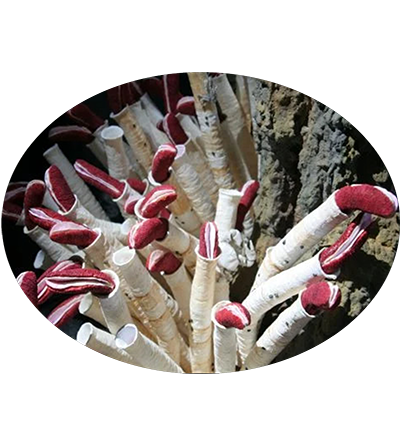
Riftia pachyptila, commonly known as the giant tube worm, is a marine invertebrate in the phylum Annelida. It inhabits hydrothermal vent ecosystems on the Pacific Ocean floor, where temperatures range from 2 to 30 °C. This species can tolerate extremely high hydrogen sulfide levels and relies entirely on symbiotic sulfur-oxidizing bacteria housed in its trophosome for nutrition. These worms can grow up to 3 meters in length, with tubular bodies reaching a diameter of 4 cm, making them one of the most iconic organisms in deep-sea vent ecosystems.
Animalia (Kingdom); Annelida (Phylum); Polychaeta (Class); Sedentaria (Subclass); Canalipalpata (Infraclass); Sabellida (Order); Siboglinidae (Family); Riftia (Genus); Riftia pachyptila (Species)
Riftia pachyptila Jones, 1981
1. Jones M L. Riftia pachyptila, new genus, new species, the vestimentiferan worm from the Galapagos Rift geothermal vents (Pogonophora)[J]. 1981. (Jones et al., 1981)
Galapagos Rift, Rose Garden geothermal vent 0.8042 (0° 48' 15" N) -86.2247 (86° 13' 29" W), 2,450 meters
| Species | Phylum | Common Name | Ecosystem | Depth | Habitat | NCBI Taxonomy ID |
|---|---|---|---|---|---|---|
| Riftia pachyptila | Annelida | Cold seep, Deep sea, Vent field | 2,514 | hydrothermal vent site Tica, East Pacific Rise (Alvin dive 4839, 9°50.398′N, 104°17.506′W) | 6426 |
| Genome Assembly | Genome Size | Assembly level | Released year | WGS accession | Submitter | BioProject | BUSCO completeness (%) | Scaffold/Contig N50 (kb) | GC content (%) | Repeat Rate (%) | Gene Number |
|---|---|---|---|---|---|---|---|---|---|---|---|
| - | 554Mb | Contig | 2023 | - | QUEEN MARY UNIVERSITY OF LONDON | PRJEB55047 | 99.37 | 2870 | 40.49 | 29.99 | 37,037 |
| Title | Journal | Pubmed ID |
|---|---|---|
| Distinct genomic routes underlie transitions to specialised symbiotic lifestyles in deep-sea annelid worms | nature communications | 37198188 |
| Gene ID | Description |
|---|---|
| RPACG04874.1 | |
| RPACG04875.1 | |
| RPACG04876.1 | |
| RPACG04877.1 | |
| RPACG04878.1 | |
| RPACG04879.1 | - |
| RPACG04880.1 | |
| RPACG04881.1 | |
| RPACG04882.1 | GTPASE, IMAP FAMILY MEMBER-RELATED |
| RPACG04883.1 | |
| RPACG04884.1 | WD REPEAT-CONTAINING PROTEIN 48 |
| RPACG04885.1 | 14-3-3 PROTEIN |
| RPACG04886.1 | MRNA TURNOVER PROTEIN 4 MRTO4 |
| RPACG04887.1 | PIKACHURIN-LIKE PROTEIN |
| RPACG04888.1 | |
| RPACG04889.1 | |
| RPACG04890.1 | CRUMBS FAMILY MEMBER |
| RPACG04891.1 | NEUROLIGIN |
| RPACG04892.1 | |
| RPACG04893.1 | POLYCYSTIN-1 |
| RPACG04894.1 | PROTEIN-COUPLED RECEPTOR GPR1, PUTATIVE-RELATED |
| RPACG04895.1 | PROTEIN-COUPLED RECEPTOR GPR1, PUTATIVE-RELATED |
| RPACG04896.1 | PROTEIN-COUPLED RECEPTOR GPR1, PUTATIVE-RELATED |
| RPACG04897.1 | POLYCYSTIN FAMILY MEMBER |
| RPACG04898.1 | |
| RPACG04899.1 | ALPHA-TECTORIN-RELATED |
| RPACG04900.1 | MANNOSE, PHOSPHOLIPASE, LECTIN RECEPTOR RELATED |
| RPACG04901.1 | EGF-LIKE DOMAIN-CONTAINING PROTEIN |
| RPACG04902.1 | ALPHA-TECTORIN-RELATED |
| RPACG04903.1 | FIBRILLIN-RELATED |
| RPACG04904.1 | |
| RPACG04905.1 | PA14 DOMAIN-CONTAINING PROTEIN |
| RPACG04906.1 | PA14 DOMAIN-CONTAINING PROTEIN |
| RPACG04907.1 | EGF-LIKE DOMAIN-CONTAINING PROTEIN |
| RPACG04908.1 | |
| RPACG04909.1 | FMRFAMIDE RECEPTOR-RELATED |
| RPACG04910.1 | |
| RPACG04911.1 | |
| RPACG04912.1 | |
| RPACG04913.1 | |
| RPACG04914.1 | |
| RPACG04915.1 | |
| RPACG04916.1 | |
| RPACG04917.1 | SUPEROXIDE DISMUTASE 2 |
| RPACG04918.1 | WILMS' TUMOR 1-ASSOCIATING PROTEIN |
| RPACG04919.1 | FIBRINOGEN/TENASCIN/ANGIOPOEITIN |
| RPACG04919.2 | |
| RPACG04920.1 | MERLIN/MOESIN/EZRIN/RADIXIN |
| RPACG04921.1 | |
| RPACG04922.1 | MERLIN/MOESIN/EZRIN/RADIXIN |

